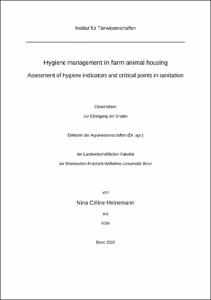Heinemann, Nina Céline: Hygiene management in farm animal housing : Assessment of hygiene indicators and critical points in sanitation. - Bonn, 2020. - Dissertation, Rheinische Friedrich-Wilhelms-Universität Bonn.
Online-Ausgabe in bonndoc: https://nbn-resolving.org/urn:nbn:de:hbz:5-59531
Online-Ausgabe in bonndoc: https://nbn-resolving.org/urn:nbn:de:hbz:5-59531
@phdthesis{handle:20.500.11811/8574,
urn: https://nbn-resolving.org/urn:nbn:de:hbz:5-59531,
author = {{Nina Céline Heinemann}},
title = {Hygiene management in farm animal housing : Assessment of hygiene indicators and critical points in sanitation},
school = {Rheinische Friedrich-Wilhelms-Universität Bonn},
year = 2020,
month = sep,
note = {Cleaning and disinfection together form an important aspect of hygiene management in livestock farming. The professional implementation of these hygiene measures can help to interrupt infection chains, prevent the spread of diseases and antibiotic-resistant bacteria and maintain a high level of animal health, animal welfare and performance. Objective hygiene indicators are needed to evaluate the success of cleaning and disinfection. Therefore, an aim of this thesis was to test different hygiene indicators from the health and food sector with regard to their suitability for use in livestock production. The focus was on visual evaluation, two different rapid tests for the measurement of protein and adenosine triphosphate (ATP) residues, microbiological contact plates, microbiological swab samples, and microbiological sock samples for the evaluation of the total aerobic count and selected target organisms. The different hygiene indicators were tested in pig fattening farms and in newborn calf rearing facilities. The evaluation showed positive correlations between the individual methods. A visual check should always be carried out prior to disinfection, independent of the use of other indicator systems. The two rapid test systems can be used for in-house training, for the self-control of commercial cleaning companies or for audits. The swab samples are superior to the contact tests for the determination of the microbiological status in livestock farming. Microbiological tests are essential for assessing the presence of specific pathogens and cannot be replaced by rapid tests. To improve hygiene management, critical points were evaluated following cleaning and disinfection in pig fattening farms, calf housing facilities and chicken fattening farms. Especially the drinking and feeding equipment was often found to be insufficiently cleaned and highly contaminated, with an average value for the total microbial count of 5.6 log10 cfu ∙ cm-2 in drinkers in fattening pig houses and 5.3 log10 cfu ∙ cm-2 in feeding troughs in fattening pig houses as well as in milk feeding buckets and artificial teats for suckling calves. After cleaning and disinfection, Pseudomonas aeruginosa was detected in the water pipes of the chicken fattening farm at all sampling points, additionally, most of them showed resistance to antibiotics. Monitoring the cleaning efficiency and careful training of staff can help to improve hygiene and reduce the spread of pathogenic and antibiotic-resistant bacteria. Special attention should be paid to critical points such as feeding and drinking equipment and pipes.},
url = {https://hdl.handle.net/20.500.11811/8574}
}
urn: https://nbn-resolving.org/urn:nbn:de:hbz:5-59531,
author = {{Nina Céline Heinemann}},
title = {Hygiene management in farm animal housing : Assessment of hygiene indicators and critical points in sanitation},
school = {Rheinische Friedrich-Wilhelms-Universität Bonn},
year = 2020,
month = sep,
note = {Cleaning and disinfection together form an important aspect of hygiene management in livestock farming. The professional implementation of these hygiene measures can help to interrupt infection chains, prevent the spread of diseases and antibiotic-resistant bacteria and maintain a high level of animal health, animal welfare and performance. Objective hygiene indicators are needed to evaluate the success of cleaning and disinfection. Therefore, an aim of this thesis was to test different hygiene indicators from the health and food sector with regard to their suitability for use in livestock production. The focus was on visual evaluation, two different rapid tests for the measurement of protein and adenosine triphosphate (ATP) residues, microbiological contact plates, microbiological swab samples, and microbiological sock samples for the evaluation of the total aerobic count and selected target organisms. The different hygiene indicators were tested in pig fattening farms and in newborn calf rearing facilities. The evaluation showed positive correlations between the individual methods. A visual check should always be carried out prior to disinfection, independent of the use of other indicator systems. The two rapid test systems can be used for in-house training, for the self-control of commercial cleaning companies or for audits. The swab samples are superior to the contact tests for the determination of the microbiological status in livestock farming. Microbiological tests are essential for assessing the presence of specific pathogens and cannot be replaced by rapid tests. To improve hygiene management, critical points were evaluated following cleaning and disinfection in pig fattening farms, calf housing facilities and chicken fattening farms. Especially the drinking and feeding equipment was often found to be insufficiently cleaned and highly contaminated, with an average value for the total microbial count of 5.6 log10 cfu ∙ cm-2 in drinkers in fattening pig houses and 5.3 log10 cfu ∙ cm-2 in feeding troughs in fattening pig houses as well as in milk feeding buckets and artificial teats for suckling calves. After cleaning and disinfection, Pseudomonas aeruginosa was detected in the water pipes of the chicken fattening farm at all sampling points, additionally, most of them showed resistance to antibiotics. Monitoring the cleaning efficiency and careful training of staff can help to improve hygiene and reduce the spread of pathogenic and antibiotic-resistant bacteria. Special attention should be paid to critical points such as feeding and drinking equipment and pipes.},
url = {https://hdl.handle.net/20.500.11811/8574}
}






